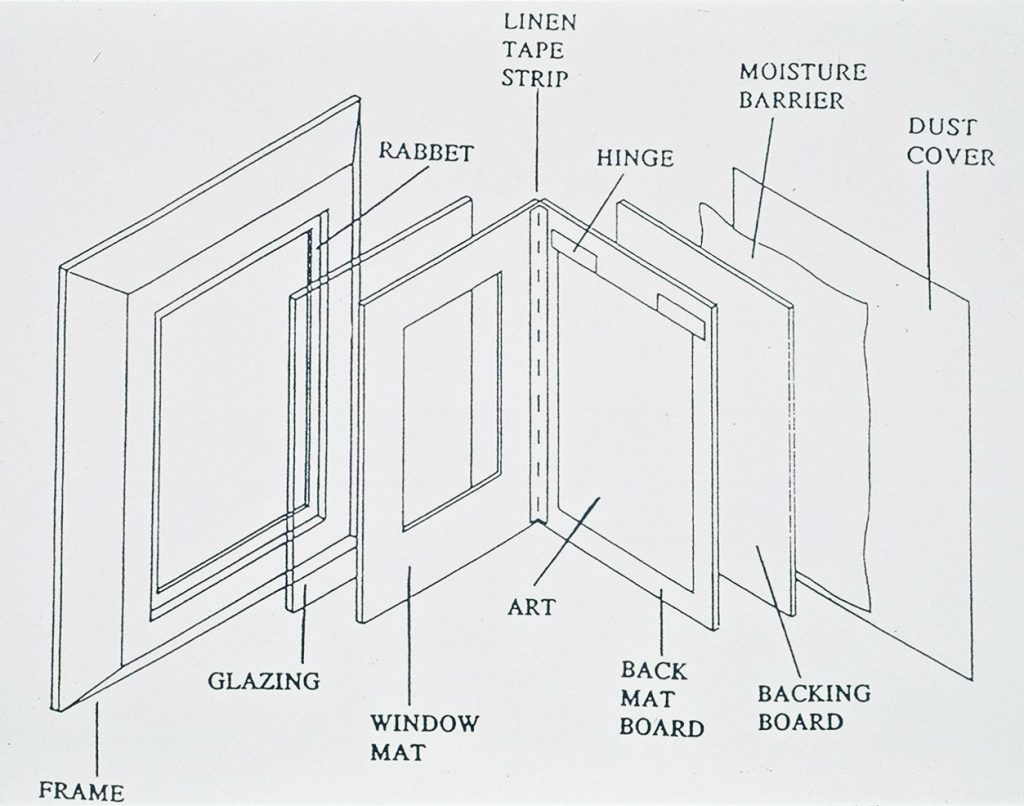The terms “archival,” “preservation,” and “conservation” are used interchangeably in picture framing to refer to framing that gives artwork the highest level of protection possible. In professional framing, this type of framing is recommended for all valued artwork, whether the value is monetary, historical, or emotional.

Criteria for Conservation Framing
All of the materials used in conservation framing must meet a list of criteria. Many products in the framing industry state on their packages that they are “acid-free.” Acid-free is a good thing, because acids are responsible for much of the deterioration of artwork. But acids are not the only source of harm, so products used in conservation framing need to have other qualities as well. They must be non-staining, and they must not deteriorate over time, exposing the art to debris or harmful gases. To be truly archival, framing must also be “reversible,” so that the art can be removed from the frame in the future with no harm caused by the framing. This is the standard used by museums and by most professional picture framers. This means, for example, that a particular type of adhesive tape may be acid-free, non-staining, and non-deteriorating, but the adhesive may be so strong that it cannot be removed from the art without the use of chemical solvents; some of that solvent will inevitably soak into the artwork, which constitutes a permanent alteration that could discolor or otherwise damage the art in the future. This tape would be unsuitable for strict conservation framing.

Professional Framers & DIY Framers
Museum curators and professional framers must adhere to strict standards of conservation framing, because they are responsible for protecting the present and future health of the art and objects they handle. They are trusted custodians (not owners) of the work they frame. DIY framers are in a different position; All decisions about framing art and objects are completely within their authority, and they may set standards as they please. Although when framing highly valued items belonging to friends and family, it is wise to consider conservation framing materials.
How should a Beginner Make Choices in Framing?
The best approach for the DIY framer is to learn about the materials and methods of conservation framing, and then make educated decisions on a project-by-project basis. The difference between regular framing and conservation framing is a matter of a few simple choices. Consult our blog or visit our website for conservation framing materials and methods, as we provide all the necessary information along with a vast range of materials for framing. The materials are readily available. The cost is a bit higher but well worth the expense to protect valued art. Even when framing decorative artwork that is not meant to last for generations, there are often practical choices that are easy to make. For example, ordinary clear adhesive tape yellows, stains what it touches, and eventually dries so much that it releases its hold, while opaque Magic Mending Tape has a clean, long-lasting adhesive that remains stable for decades. So why not use the stable one instead?
Enemies of Framed Art – How Long Will It Last?
Many factors influence the life of a framed picture. For most artwork, longevity comes from a combination of proper framing and protection from environmental damage while the framing is on display.
| Cause of Harm | Source of Harm | Potential Damage | Protection Framing Can Provide |
| Handling | Hands, poor storage, faulty repairs | Fingerprints, creases, stains | Complete protection if art is covered with glazing |
| Insects | Tasty items in frame, such as wool or paste | Holes, overall deterioration | Good protection, unless insects are sealed inside the frame |
| Moisture/ Humidity | Damp or steamy places, such as bathrooms, kitchens, screened porches, boats, shore cottages | Warping, buckling, and mold | Framing slows absorption a bit, but this problem must be controlled by placement of framed art or by controlling the environment |
| Air Pollution | Chemicals, insecticides, cooking grease, fireplace smoke and ash | Stains and discoloration | Framing provides good protection if art is covered with glass or acrylic |
| Light | Sunshine, incandescent, fluorescent, halogen, picture lights | Fading | Proper framing can help, but fading is best controlled by avoiding strong light |
| Heat and Cold | Extreme temperatures and extreme changes | Warping, buckling | Can be controlled by proper framing and choice of hanging location |
| Acids and Gases | Framing materials or the art itself | Discoloration and deterioration | Proper framing can prevent damage caused by materials and mitigate internal weaknesses |
When should a DIY framer consult Custom Framing Wholesale?
Complex Project
Whenever a project is too complex or too large for the equipment, skill level, or workspace available; when special materials are not available to the DIY framer; or when the artwork in question is so fragile or valuable that professional help is necessary.
If you choose to have your artwork framed by a professional custom picture framer, this blog can help you be an informed customer. Knowledge of color choices, design, and framing standards will help you to make decisions at the frame shop and evaluate the custom work you have done.
Professional Standards
Most professional picture framers enjoy their profession and work hard to be very good at it. However, the expertise and experience of professional picture framers varies. To choose a framer, look for indications of professional standards.
In the U.S. and Canada, membership in the Professional Picture Framers Association (PPFA) lets customers know that a framer is interested in staying active within the industry and keeping up with current standards. The Fine Art Trade Guild (FATG) is the trade association in the UK. Both organizations offer certification programs. Some chain stores have their own training programs and successful candidates earn in-house certification. There are also picture framing schools that offer training. Look for certificates or signage that indicates the framer has taken classes or participated in training. Or just talk to the framer about how they got into the profession—some very fine framers learned the job simply by working for years in good frame shops.
Word of Mouth
Word-of-mouth can be a good way to find a professional framer. If a friend, neighbor, or family member recommends a business, it means they are satisfied enough to be proud of their choice.
